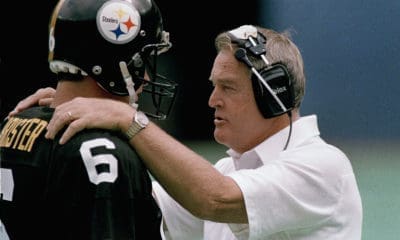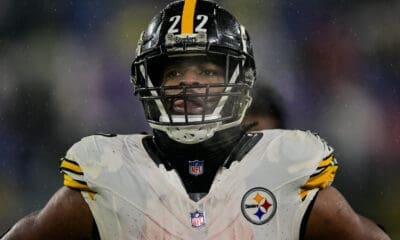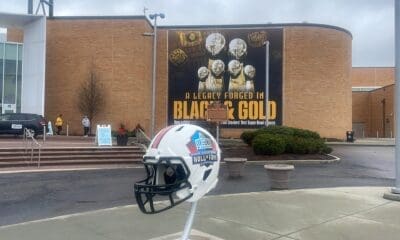Steelers News
Exclusive with Lionel Taylor, Steelers Wide Receiver Coach, 1970-1976

Lionel Taylor was the Steelers wide receivers coach during their first two Super Bowl wins (1974, 1975) and helped develop Hall-of-Famers Lynn Swann and John Stallworth. Taylor, a standout receiver for the Denver Broncos was also one of the first black coaches in the NFL.
First, tell me a bit about what you’ve done since you retired from coaching?
I worked for IMG sports Academy for about six or seven years, working with guys like Eli Manning, Chad Pennington, and Thomas Jones, getting them ready for the draft. Worked with a lot of first round guys. IMG – they get good people.
So stepping back – you were a good basketball player and track athlete in high school. How did football become your career?
Oh – I wasn’t good at any of them! Football wasn’t my decision – it just fell that way for me. I wanted to play basketball in high school but in order to play basketball you also had to play football. There were only 190 kids in my school and the basketball coach was the football coach!
My first year playing football there we had to practice in the gym one day because it was raining and we were just throwing the ball around and I caught everything, so the coach moved me to end after seeing that. I liked that because you didn’t get too much attention then at end from the defense – we didn’t throw much then.
And yet somehow you ended up signing with the Chicago Bears as a linebacker?
Let me tell you, I never played linebacker there. When you go to New Mexico Highlands University, you have to play every position, it’s such a small school. Chicago had me try out at linebacker and defensive back. In college I filled out a postcard with my coach about my play in college – that was my scouting report.
I didn’t last long with the Bears and they released me shortly after I got there. I came back again as a wide receiver but never raised any heck there. I played eight games, but there is no way we can talk about my linebacker ability!
Yet you made it in the NFL though and became a terrific wide receiver. How did that happen?
I tell people, if you want to become a good wide receiver you have to remember two things. It only hurts half as much when you catch the ball, and it hurts all the way when you drop one! You have to expect to get hit. Nothing hurts more when you drop the ball and get hit!
The fans tell you about the job you’re doing. If they cheer or boo, or go whoooah if you get hit and make the catch. And I’m here to tell you, if I heard the fans go whoooah after a big catch and I got hit, I may have milked it and just laid down there a little longer!
I grew up in West Virginia where we didn’t have much. We played football with Carnation Milk cans. We had to have good hand-eye coordination. When I played in the NFL we called them Sunday Show Days. I always wanted to beat the guys I lined up against at their strongest suit – if they were good on the outside I wanted to beat them outside If they were good inside I wanted to beat them inside. If I could beat them on their best route, that gave me confidence. I would sometimes even tell guys what route I was going to run and beat them then. Tell them they were’t going to throw to me anyway. If it was intercepted that would have been big trouble for me!
How did you prepare physically?
I worked out and hard – all the time. For the first couple of weeks when I started working out I wouldn’t catch passes. I wanted to get in shape first, then I’d start catching passes.
I always stayed late after practices. Me and Willie Brown when I was in Denver, we’d have contests to see who could catch seven passes out of ten. The winner got 50 cents. These had to be tough routes with a guy throwing to us. If it was a bad pass it didn’t matter, it counted against you. I have to say he won most of those contests!
How did your playing experiences shape who you became as a coach?
The first thing I learned was that I couldn’t coach people to play the way I played, I had to coach according to the personnel. I was lucky to coach under Chuck Noll – he was a great individual. He was a technique person like me. I had no speed so I had to be a technician.
I also let guys know it was a business. If we became friends that was a plus. I’d tell that to everyone in the room. We could bring in as many guys as we wanted then – there were no limitations. So we would have fifteen guys for six jobs and I’d tell them to pull for each other – don’t pull against each other. If you helped each other and did a good job, other teams will see you even if you don’t make this team and bring you in. The Steelers became so good then that other teams started looking at our players. Guys started busting their butts. They gave all they could.
How did you coach those guys up? Especially guys like Swann and Stallworth?
I chewed them up about their blocking early on. I showed them highlights of my playing time, but I forgot then that I didn’t block either! So they gave me hell for that!
I taught them that when you’re a wide receiver, no one is over you at the line. You have to run to get covered. Run into the traffic. So you have to use technique to separate. If you can’t separate you can’t play. I’d show them how to do it. Repetition was key. It took two years for a player to know their coach. I remember his second year there I heard Lynn Swann giving other guys the Lionel Taylor speech in the locker room!
So, why do you think Coach Noll brought you in to coach in Pittsburgh?
I coached at the college All-Star game in 1969. Otto Graham was the coach and asked me to be one of his coaches. Before the game he’d go around to each coach and talk about each unit. I was in the back of the room and when he got to me I gave him my whole gameplan for the receivers. He just about passed out!
When I went to Denver Chuck Noll called me. He was the defensive coach for San Diego when I played in Denver so maybe that helped. I wasn’t that enthused at the first thought of going to Pittsburgh to coach. I thought about it and then flew to Pittsburgh to talk with him. I was delayed twenty hours due to fog – we couldn’t land. I met him at the old Roosevelt Hotel and walked up all of those steps. I thought they must have been broke! Chuck and I talked and went through film.
Anything specific you tell him?
I told him he wasn’t using all of the field in the passing game. We talked about technique – stuff like that.
When I left he gave me a $600 check for expenses. I told him it was way too much – it didn’t cost that much. He said to keep it for miscellaneous expenses. I had a better feeling then. I thought I did a lousy job at the interview. So I wrote him a letter when I got back explaining what I thought my contribution to the team could be. Three days later he called me and asked if I wanted the job. I asked if he got the letter and he said he hadn’t yet. I told him he may want to read the letter first! I actually saw the letter later and was embarrassed. I misspelled a word!
How was Chuck to work for?
Chuck would let you do your work and not get involved – if you did your thing right.
My first meeting with the staff, he went around the table and asked all the coaches what they felt about their units. I told him we should cut all of our veteran receivers. That our young guys would be better than them all in two years.
Tell me a bit about some of those young guys and how you helped them?
Ron Shanklin, Frank Lewis, John Stallworth and Lynn Swann – four All Pros. How do you coach those guys? My answer was to treat each guy just like anyone else.
When I coached in London a kicker there gave me the greatest compliment I ever received from a player. He told people that I treated everyone the same. That’s what you have to do. You have to treat the All Pros the same way you treat a guy with little chance. I’ve been around coaches that say little to veteran players. But I chewed out veterans too if they did anything wrong.
I had two players in my career as a coach who never took plays off in practice or in games. Stallworth was one of them. One time he had nicked himself – a little injury. I told him to slow it down – he was going full blast. We ended up arguing about it. Swann and Shanklin, they’d take plays off. But not Stallworth.
I also would always talk to guys out loud. Some coaches, they put their arm around players shoulders and tell them what they need to do. But the other ten guys don’t hear that though. Not to embarrass them, but I would always say it out loud. I’m coaching all the guys that way. Ron Shanklin once got mad at me for that and went in to complain to Chuck Noll. He told Chuck I was the only guy yelling at the players. I told him fine – go talk to him. He came back to me later and told me he knew Chuck would take my side.
I told the guys I knew they got upset at me. Sweating all day, running routes and cursing me out as I yelled at them. I told them it doesn’t matter what they say, so go for it. It made for good relationships.
How close were the receivers?
The best thing I had going was Shanklin and Lewis, then Stallworth and Swann all fighting for a position. That was my great coaching. Them all fighting for positions.
Before the draft we were deciding on whether we wanted to draft Swann or Stallworth round one. Chuck was leaning towards Stallworth but Haley said Stallworth would be there around round four. At the Senior Bowl I saw Stallworth play. One play he ran down the sideline and had his guy beat but the pass was under-thrown and he waited on it and the defensive back knocked it away. The coach talked to him right after the play and later on he had his guy beat again on the sideline and again the ball was under-thrown. This time Stallworth jumped back into the ball and caught it. Whatever the coach told him he listened to and right then I knew Stallworth was a coachable player.
Some questioned Swann’s speed. But the only thing I told the scouts was that all he did was get open and catch the ball. Shanklin was smooth as silk. Lewis could fly. He was a wingback at Grambling so he took some time to develop.
Any funny stories of your time as a coach?
Chuck let each coach handle their own groups. But one day Chuck came back in to the receivers meeting room and saw us all eating cake and watching my highlight film. I was sweating. He just looked at me and walked out.
I also remember Myron Cope once came in and asked me if we had a Jewish football player. I was like, what? I didn’t know Randy Grossman was Jewish. Randy made the team that year. But I had no idea what he was talking about. I was from West Virginia. I had no idea about last names!
I also remember Terry Hanratty coming over to the sideline after calling a timeout. Usually a group of coaches gather around the quarterback and all tell him what to do. I thought I would be smarter than all of the other coaches and told them all to be quiet so we could hear what the Terry had to say. Terry just looked at me and said “I’ve got nothing. That’s why I called the timeout!” I knew after that to keep my mouth shut!
Any success stories you’re most proud of?
Randy Grossman. Just by his size he was a reject. But it’s not the size of the dog but the fight in the dog. He caught everything. If he dropped a pass it was like knocking a tooth out, it hurt him so much.
He worked so hard. He ran every play for us at tight end during the strike. It wasn’t so much what I did–it was what he did. He wasn’t fast but he could separate as good as anybody. I used to tell him that because he wasn’t a big or heavy guy, that he needed to be quick to the defenders and the block. Get to them and at least get in their way before they slam you down!
Randy’s dad used to come to training camp every year and bring me a bottle of Crown Royal!
Is that how he made the team?
Ha! No – but that is good!
How did Bradshaw and Hanratty work with the receivers?
Bradshaw, he didn’t have the great stats as far as completion rates but no one would in our system. People don’t understand that. It’s not like the run and shoot or the spread offense people run today. We threw it deep – downfield. Terry came from a small school. He had no quarterback coach until Babe Parilli was brought in. He did a great job.
When Terry first got here we were terrible. Fans jumped all over him. But he was a good athlete. He could throw and run. He would drive me crazy at times early on. He’d mix up some plays if we gave him a few at one time to start the game with. We had to work with him to put some air under the ball. Use some touch. When I was at IMG, I had to work with Eli on the same thing.
What do you think about how the game has changed since you coached?
From my viewpoint, I like the play today. They don’t beat you up as much. The bump and run then, they’d line up over your head. Guys like Blount and Willie Brown, they’d make you fight to get off the line and could still do that after five yards. Now the defensive backs are at a disadvantage.
I do like how they are taking care of the players and especially the quarterbacks more, tough I don’t think they do a good job protecting Cam Newton – they let him get killed. They take care of Brady. And Ben – he doesn’t need the help. He’s such a big guy he trows people off of him!
Lastly, you were one of the earliest black coaches in the NFL. Was that something that was on your mind then – did that matter to you then?
There was a magazine in Pittsburgh that asked coaches then how long they thought it would take before the NFL would have a Black NFL head coach. I told them twenty years. They thought I was crazy. First, any team would want a coach to be a defensive or offensive coordinator first. You just don’t make it as an assistant. It’s also a business. There were more White than Black people in the stands…
But no, I didn’t think about it then. It didn’t mean anything. I just wanted the opportunity to be the best coach at my position that I could be. I didn’t care about anything else.
















